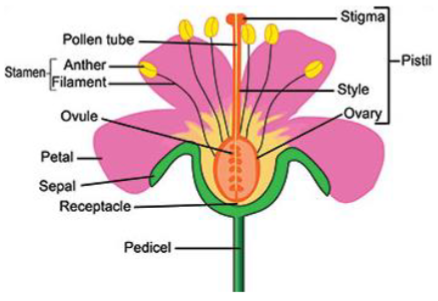Smart Self-Pollination for Future Agricultural-A Computational Structure for Micro Air Vehicles with Man-Made and Artificial Intelligence
Keywords:
pollination, pollinator, robobee, sensor, vehicleAbstract
: As pollination is an important role in agriculture to yield many fruits. This is diminished due to the use of fertilizers. This leads the honey bee not get attracted with the flowers with its colours and odour. So smart self-pollination is applied using Micro Air Vehicle (MAV) like MAV Pollinators (MPrs). In this the movement of the bees are not happening in a sufficient way due to the absence of artificial intelligence. Further the mean square error is not calculated. Also, if there are a greater number of bees it may fly in the same direction due to the absence of mentioning the direction. Also, from the fly the information is not carried directly to the environment. This leads to a decrease in the rate of pollination. This is remedy by proposing a new micro air vehicle with robo bee. In this clustering is made for finding the centroid. Based on the formation of the clusters, the robobee is let to fly. Now the direction for the robobee needs to be determined in each cluster. This is done by using particle swarm optimization. Based on which the findings like dimensions, number of boids and the number of Epochs are found and based on the calculations the robobee was let to fly. As the wings and body in the robobee is connected on the basis of artificial intelligence, it will help to update periodically and the pollination will happen smartly without any human intervention.
Downloads
References
M. Ayaz, M. Ammad-Uddin, Z. Sharif, A. Mansour and E. M. Aggoune, "Internet-of-Things (IoT)-Based Smart Agriculture: Toward Making the Fields Talk," in IEEE Access, vol. 7, pp. 129551-129583, 2019, doi: 10.1109/ACCESS.2019.2932609.
Tom Duckett, Simon Pearson, Simon Blackmore, Bruce Grieve “Agricultural Robotics: The Future of Robotic Agriculture”
Y. Chen and Y. Li, "Intelligent Autonomous Pollination for Future Farming - A Micro Air Vehicle Conceptual Framework With Artificial Intelligence and Human-in-the-Loop," in IEEE Access, vol. 7, pp. 119706-119717, 2019, doi: 10.1109/ACCESS.2019.2937171.
Stephan De Spiegeleire, Matthijs Maas, Tim Sweijs, “Artificial Intelligence And The Future Of Defense Strategic Implications For Smalland Medium-Sized Force Providers”
Partha Pratim Ray, “Internet of things for smart agriculture: Technologies, practices and future direction},journal = {Journal of Ambient Intelligence and Smart Environments”, Journal of Ambient Intelligence and Smart Environments 9 (2017) 395–420.
Project website of the Wyss Institute, Harvard - https://wyss.harvard.edu/technology/autonomous-flying-microrobots-robobees/
"RoboBees: Robotic insects make first controlled flight (w/ video)". Phys.org. May 2, 2013. Retrieved May 3, 2013.
Rachel Ross (July 19, 2007). "Robotic Insect Takes Off". Technology Review. Retrieved May 3, 2013.
Redesign of the Micromechanical Flying Insect in a Power Density Context. p. 3.
Wood, Robert; Nagpal, Radhika; Wei, Gu-Yeon (March 11, 2013). "Flight of the robobees". Scientific American. 308 (3): 60–65. Bibcode:2013SciAm.308c..60W. doi:10.1038/scientificamerican0313-60. PMID 23469434.
Ma, Kevin Y.; Chirarattananon, Pakpong; Fuller, Sawyer B.; Wood, Robert J. (May 2013). "Controlled Flight of a Biologically Inspired, Insect-Scale Robot". Science. 340 (6132): 603–607. Bibcode:2013Sci...340..603M. doi:10.1126/science.1231806. PMID 23641114.
Amina Khan (May 2, 2013). "Meet RoboBee, a bug-sized, bio-inspired flying robot". Los Angeles Times. Retrieved May 2, 2013.
Davis, Shoshana (May 2, 2013). ""RoboBees" take first flight". CBS News. Retrieved May 3, 2013.
Graule, Moritz A.; Chirarattananon, Pakpong; Fuller, Sawyer B.; Jafferis, Noah T.; Ma, Kevin Y.; Spenko, Matthew; Kornbluh, Roy; Wood, Robert J. (May 2016). "Perching and takeoff of a robotic insect on overhangs using switchable electrostatic adhesion". Science. 352 (6288): 978–982. Bibcode:2016Sci...352..978G. doi:10.1126/science.aaf1092. PMID 27199427.
Reeve, Elspeth. "Robot Hummingbird Drone Is Military's Latest Spy Toy". The Atlantic Wire. Retrieved May 6, 2013.
"FAA Releases New Drone List—Is Your Town on the Map?". Electronic Frontier Foundation. Retrieved May 6, 2013.
"Texas Declares War on Robots". Robots.net. Retrieved May 6, 2013.
"City in Virginia passes anti-drone resolution". Los Angeles Times. Retrieved May 6, 2013.
Potts, S.G.; Neumann, P.; Vaissière, B.; Vereecken, N.J. (June 2018). "Robotic bees for crop pollination: Why drones cannot replace biodiversity". Science of the Total Environment. 642: 665–667. Bibcode:2018ScTEn.642..665P. doi:10.1016/j.scitotenv.2018.06.114. PMID 29909334

Downloads
Published
How to Cite
Issue
Section
License
Copyright (c) 2022 Priscilla Joy, Roshni Thanka, Bijolin Edwin

This work is licensed under a Creative Commons Attribution-ShareAlike 4.0 International License.
All papers should be submitted electronically. All submitted manuscripts must be original work that is not under submission at another journal or under consideration for publication in another form, such as a monograph or chapter of a book. Authors of submitted papers are obligated not to submit their paper for publication elsewhere until an editorial decision is rendered on their submission. Further, authors of accepted papers are prohibited from publishing the results in other publications that appear before the paper is published in the Journal unless they receive approval for doing so from the Editor-In-Chief.
IJISAE open access articles are licensed under a Creative Commons Attribution-ShareAlike 4.0 International License. This license lets the audience to give appropriate credit, provide a link to the license, and indicate if changes were made and if they remix, transform, or build upon the material, they must distribute contributions under the same license as the original.





